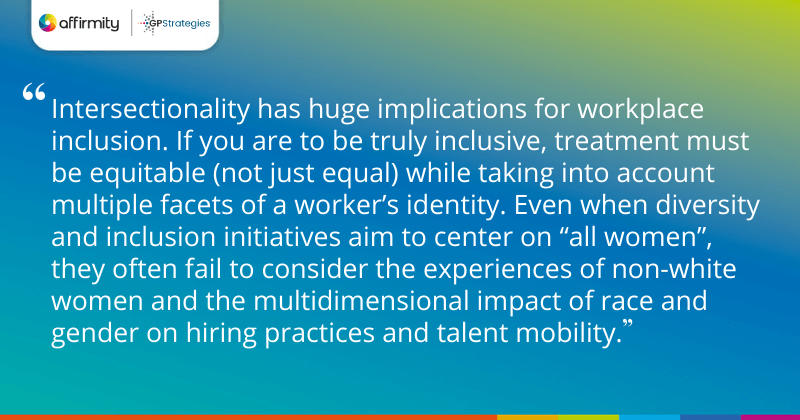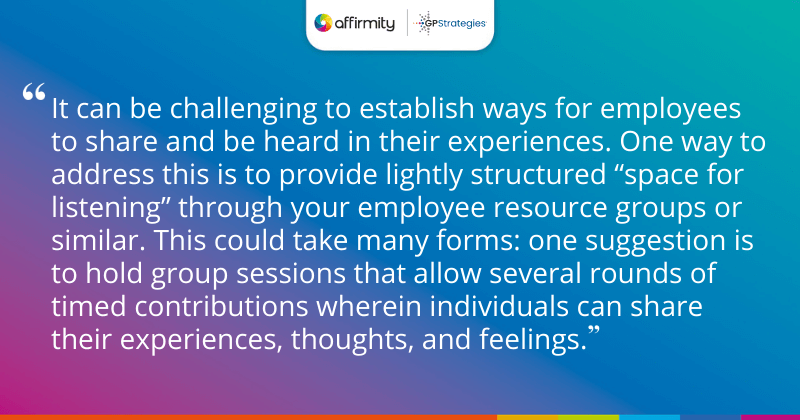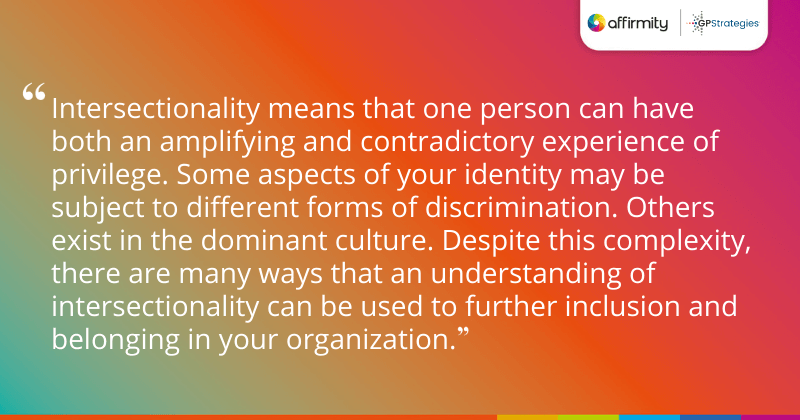What is intersectionality and why is it important to factor into your DE&I efforts? In this article we examine this key way of understanding people’s experiences and suggest a number of ways that organizations can help employees bring every aspect of their identity to the workplace.
Humans are multifaceted creatures. No one individual can be reduced down to a single social identity that defines everything about them. This layering of identities is an essential part of how we navigate the world: whether consciously or unconsciously, we form “in groups” and “out groups” in every aspect of our lives.
The term “intersectionality” was coined by lawyer and civil rights advocate Kimberlé Crenshaw to describe the complex interaction of layered identities when describing the experiences of Black women in the workplace. The idea has since gained traction as a way of describing the systems of inequality that exist in any combination of characteristics.
What Intersectionality Means for Your DE&I Efforts

Depending on your gender, race, ethnicity, class, sexuality, gender identity, disability, neurodiversity, or other attributes, you may be subject to many different forms of discrimination or privilege. These factors not only stand alone but create different dynamics that subtly change how we approach everything the world throws at us.
In the workplace, they affect the ease with which we access and hold power. And while intersectional experiences are significant, employers have typically struggled to consider or account for them. For example, employers struggle in terms of diversity reporting and data. As individuals have multiple marginalized identities, they can be a source of duplication and give a false sense of the number of diverse individuals in an organization. Misuse of this data could lead to a tokenistic approach.
Intersectionality has huge implications for workplace inclusion. If you are to be truly inclusive, treatment must be equitable (not just equal) while taking into account multiple facets of a worker’s identity. Black women may experience racism as well as sexism, and are typically less likely to benefit from the working world’s pushes to improve the representation of women, or of people of color. Even when diversity and inclusion initiatives aim to center on “all women”, they often fail to consider the experiences of non-white women and the multidimensional impact of race and gender on hiring practices and talent mobility.
Meanwhile, male CEOs claim the top spots at the largest Fortune 500 corporations. In 2021, just 41 organizations had a female CEO. Shockingly, 2021 was notable for being the first year in which the annual list has ever featured more than one Black woman CEO, namely Walgreens’ Roz Brewer and TIAA’s Thasunda Brown Duckett. That’s 41 women and 2 Black women out of 500 CEOs. Both figures were noted as record breaking.
HELP ON DEFINITIONS | ‘What is Fair Pay? And What’s the Difference Between Equity and Equality?’
3 Ways Organizations Can Account for Intersectionality

Organizations everywhere are waking up to the need to consider intersectionality, but awareness needs to translate into action. Policies and inclusive practices need to be created both internally and externally to ensure an authentic commitment. For example:
1) Create Space for Listening
It can be challenging to establish ways for employees to share and be heard in their experiences. One way to address this is to provide lightly structured “space for listening” through your employee resource groups or similar. This could take many forms: one suggestion is to hold group sessions that allow several rounds of timed contributions wherein individuals can share their experiences, thoughts, and feelings. As “space for listening” suggests, the benefit isn’t just in allowing each participant time to speak—they’re there to listen too.
MORE ON EMPLOYEE RESOURCE GROUPS | ‘Maximizing the Value of ERGs: Expert Answers to 7 Burning Questions’
2) Celebrate Difference
There’s no shortage of workplaces that have an outward appearance of harmony that is ultimately achieved by individuals forced into hiding aspects of themselves to simply “get along”. These acts of workplace assimilation ultimately foster feelings of isolation and resentment among staff who feel they have to repress part of themselves to avoid conflict.
You may not have policies that actively punish difference, but failing to celebrate difference can have much the same effect. So acknowledge the diverse pool of talent in your organization, celebrate each unique facet of it and make sure that your people feel they can bring more of themselves into the workplace.
3) Eliminate Bias From Talent Acquisition
Do your job postings ever use phrases such as “cultural fit for the team”? That phrase alone can be a source of considerable bias, and talent acquisition teams have a responsibility to steer away from it (and similar phrases). Such non-measurable criteria only really exist to railroad decision-makers into excluding anyone who doesn’t fit in with the dominant culture.

FAIR DATA COLLECTION FOR TALENT ACQUISITION | ‘4 Factors That Will Keep Your Talent Acquisition Data Clean for DE&I’
Some Final Thoughts
In a 1982 address about the contemporary struggles of civil rights movements and what they could learn from those of the 60s, civil rights activist Audre Lorde said: “There is no such thing as single-issue struggles because we do not lead single-issue lives.” Intersectionality means that one person can have both an amplifying and contradictory experience of privilege. Some aspects of your identity may be subject to different forms of discrimination. Others exist in the dominant culture.
Despite this complexity, there are many ways that an understanding of intersectionality can be used to further inclusion and belonging in your organization. The journey towards an equitable workforce is a long, ongoing one. But by centering employee needs and amplifying the voices of the marginalized you can take significant and invaluable steps forward.
Affirmity’s DE&I solutions include measurement, analysis, training, consultancy, and more. Contact us today to find out more.
A version of this article originally appeared on c-levelmagazine.com.
 About the Author
About the Author
Taniya Sonko is a Global Account Director for DE&I at GP Strategies. She is an equity, diversity and inclusion professional with experience in consultancy and training in both the public and private sectors. Her passion for tackling social injustice has led her to work with organizations ranging from grassroots community collectives to intergovernmental bodies such as the United Nations, and large corporations.
